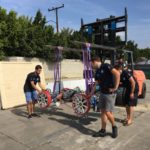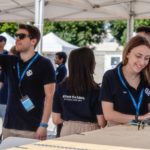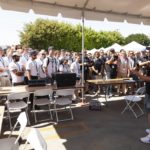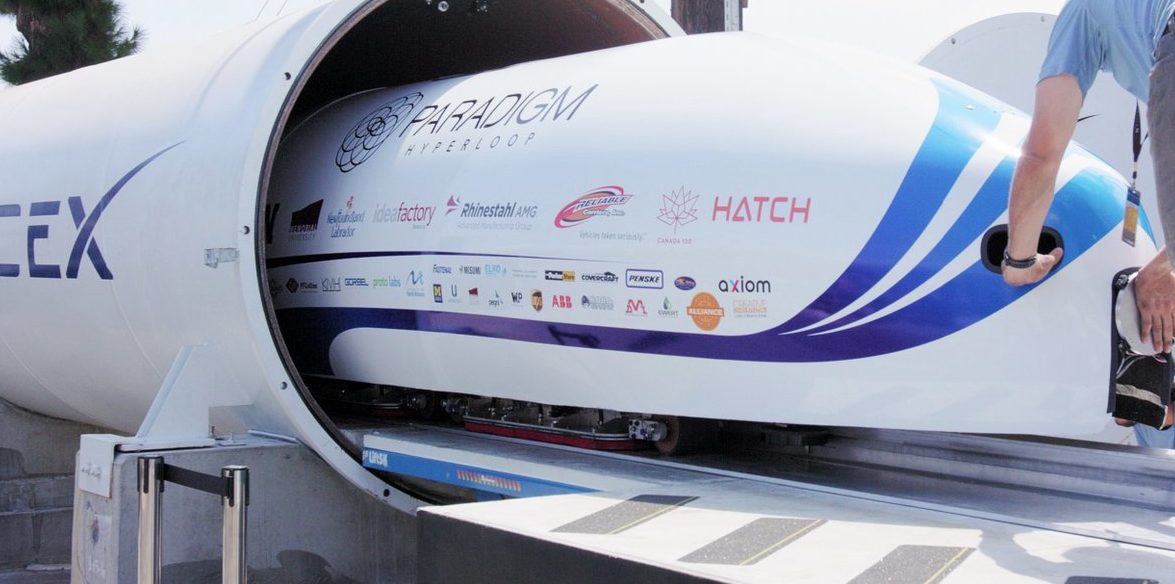
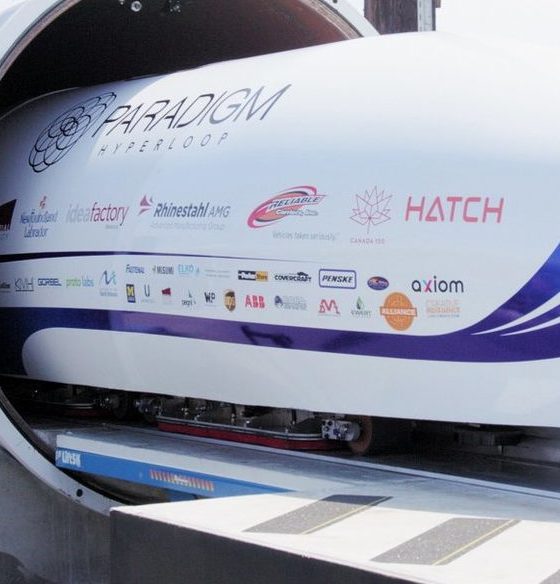
News
SpaceX’s Hyperloop competitors are preparing to set top speed records
The 2018 Hyperloop Pod Competition is set to be held this Sunday, July 22, 2018, at SpaceX’s campus in Hawthorne, CA. Participants for this Sunday’s event, which are comprised of roughly 600 students from 40 countries, will be aiming for one target alone — setting top speed records in SpaceX’s 0.8-mile test track.
As a teaser for this weekend’s event, Elon Musk recently shared images of some competitors already making preparations for the upcoming competition. Considering the theme of this year’s event, all 20 teams (comprised of 18 main competition teams and 2 levitation sub-competition groups) will be attempting to beat the top speed record currently held by Virgin Hyperloop One on the SpaceX test track. Last December 2017, Virgin Hyperloop One’s pod was able to reach a speed of 240 mph, beating out the record set by a Tesla-branded pusher pod that was able to hit 220 mph before it started heating up.
- Participants for SpaceX’s 2018 Hyperloop Pod Competition prepare for the event. [Credit: Hyperloop/Twitter]
- Participants for SpaceX’s 2018 Hyperloop Pod Competition prepare for the event. [Credit: Hyperloop/Twitter]
- Participants for SpaceX’s 2018 Hyperloop Pod Competition prepare for the event. [Credit: Hyperloop/Twitter]
Participants for SpaceX’s 2018 Hyperloop Pod Competition prepare for the event. [Credit: Hyperloop/Twitter]
Among the student teams that would be participating this year, one group to watch would be WARR Hyperloop, a team from the Technical University of Munich that won the fastest pod award last year. The team was able to accomplish last year’s feat by designing a lightweight pod propelled by a 50 kW electric motor that runs on polyurethane wheels. The pod, which only weighed 190 pounds, was able to hit 202 mph, blowing away the speed records of its two biggest competitors — Paradigm Hyperloop and SwissLoop.
WARR Hyperloop’s team for this Sunday’s competition is comprised of 45 members from 16 different countries. In order to keep its top speed crown this year, Team WARR has created a new pod that is specifically designed to beat its old speed records and possibly even surpass the figure set by Virgin Hyperloop One. In a press release last month, the team from the Technical University of Munich stated that they are hoping their new pod could hit speeds of 372 mph (600 kph).
Another team that would be returning this year would be Delft Hyperloop from the Delft University of Technology. Just like Team WARR, Team Delft is also returning to the event as a champion, having won the overall top prize at SpaceX’s first event in January 2017. According to team leader Edouard Schneiders, Delft’s pod this year has a strong power-to-weight ratio, which would likely enable it to beat not only its competitors, but Virgin Hyperloop One’s 240 mph record as well.
Hyperloop technology has progressed over the years since Elon Musk first mentioned the idea of a “fifth mode of transportation” back in 2012. Since then, the idea has been picked up by companies in several countries, most notable of which is Virgin Hyperloop One’s project in Dubai, which is expected to debut as early as 2020. Earlier this year, Virgin Hyperloop One unveiled a 1:1 model of its transport pod, which features futuristic design elements and plush amenities.

News
Elon Musk’s Grokipedia surges to 5.6M articles, almost 79% of English Wikipedia
The explosive growth marks a major milestone for the AI-powered online encyclopedia, which was launched by Elon Musk’s xAI just months ago.

Elon Musk’s Grokipedia has grown to an impressive 5,615,201 articles as of today, closing in on 79% of the English Wikipedia’s current total of 7,119,376 articles.
The explosive growth marks a major milestone for the AI-powered online encyclopedia, which was launched by Elon Musk’s xAI just months ago. Needless to say, it would only be a matter of time before Grokipedia exceeds English Wikipedia in sheer volume.
Grokipedia’s rapid growth
xAI’s vision for Grokipedia emphasizes neutrality, while Grok’s reasoning capabilities allow for fast drafting and fact-checking. When Elon Musk announced the initiative in late September 2025, he noted that Grokipedia would be an improvement to Wikipedia because it would be designed to avoid bias.
At the time, Musk noted that Grokipedia “is a necessary step towards the xAI goal of understanding the Universe.”
Grokipedia was launched in late October, and while xAI was careful to list it only as Version 0.1 at the time, the online encyclopedia immediately earned praise. Wikipedia co-founder Larry Sanger highlighted the project’s innovative approach, noting how it leverages AI to fill knowledge gaps and enable rapid updates. Netizens also observed how Grokipedia tends to present articles in a more objective manner compared to Wikipedia, which is edited by humans.
Elon Musk’s ambitious plans
With 5,615,201 total articles, Grokipedia has now grown to almost 79% of English Wikipedia’s article base. This is incredibly quick, though Grokipedia remains text-only for now. xAI, for its part, has now updated the online encyclopedia’s iteration to v0.2.
Elon Musk has shared bold ideas for Grokipedia, including sending a record of the entire knowledge base to space as part of xAI’s mission to preserve and expand human understanding. At some point, Musk stated that Grokipedia will be renamed to Encyclopedia Galactica, and it will be sent to the cosmos.
“When Grokipedia is good enough (long way to go), we will change the name to Encyclopedia Galactica. It will be an open source distillation of all knowledge, including audio, images and video. Join xAI to help build the sci-fi version of the Library of Alexandria!” Musk wrote, adding in a later post that “Copies will be etched in stone and sent to the Moon, Mars and beyond. This time, it will not be lost.”
News
Tesla Model 3 becomes Netherlands’ best-selling used EV in 2025
More than one in ten second-hand electric cars sold in the country last year was a Tesla Model 3.

The Tesla Model 3 became the most popular used electric car in the Netherlands in 2025, cementing its dominance well beyond the country’s new-car market.
After years at the top of Dutch EV sales charts, the Model 3 now leads the country’s second-hand EV market by a wide margin, as record used-car purchases pushed electric vehicles further into the mainstream.
Model 3 takes a commanding lead
The Netherlands recorded more than 2.1 million used car sales last year, the highest level on record. Of those, roughly 4.8%, or about 102,000 vehicles, were electric. Within that growing segment, the Tesla Model 3 stood far ahead of its competitors.
In 2025 alone, 11,338 used Model 3s changed hands, giving the car an 11.1% share of the country’s entire used EV market. That means more than one in ten second-hand electric cars sold in the country last year was a Tesla Model 3, Auto Week Netherlands reported. The scale of its lead is striking: the gap between the Model 3 and the second-place finisher, the Volkswagen ID3, is more than 6,700 vehicles.
Rivals trail as residual values shape rankings
The Volkswagen ID.3 ranked a distant second, with 4,595 used units sold and a 4.5% market share. Close behind was the Audi e-tron, which placed third with 4,236 registrations. As noted by Auto Week Netherlands, relatively low residual values likely boosted the e-tron’s appeal in the used market, despite its higher original price.
Other strong performers included the Kia Niro, the Tesla Model Y, and the Hyundai Kona, highlighting continued demand for compact and midsize electric vehicles with proven range and reliability. No other model, however, came close to matching the Model 3’s scale or market presence.
News
Tesla Model Y Standard Long Range RWD launches in Europe
The update was announced by Tesla Europe & Middle East in a post on its official social media account on X.

Tesla has expanded the Model Y lineup in Europe with the introduction of the Standard Long Range RWD variant, which offers an impressive 657 km of WLTP range.
The update was announced by Tesla Europe & Middle East in a post on its official social media account on X.
Model Y Standard Long Range RWD Details
Tesla Europe & Middle East highlighted some of the Model Y Standard Long Range RWD’s most notable specs, from its 657 km of WLTP range to its 2,118 liters of cargo volume. More importantly, Tesla also noted that the newly released variant only consumes 12.7 kWh per 100 km, making it the most efficient Model Y to date.
The Model Y Standard provides a lower entry point for consumers who wish to enter the Tesla ecosystem at the lowest possible price. While the Model 3 Standard is still more affordable, some consumers might prefer the Model Y Standard due to its larger size and crossover form factor. The fact that the Model Y Standard is equipped with Tesla’s AI4 computer also makes it ready for FSD’s eventual rollout to the region.
Top Gear’s Model Y Standard review
Top Gear‘s recent review of the Tesla Model Y Standard highlighted some of the vehicle’s most notable features, such as its impressive real-world range, stellar infotainment system, and spacious interior. As per the publication, the Model Y Standard still retains a lot of what makes Tesla’s vehicles well-rounded, even if it’s been equipped with a simplified interior.
Top Gear compared the Model Y Standard to its rivals in the same segment. “The introduction of the Standard trim brings the Model Y in line with the entry price of most of its closest competition. In fact, it’s actually cheaper than a Peugeot e-3008 and costs £5k less than an entry-level Audi Q4 e-tron. It also makes the Ford Mustang Mach-E look a little short with its higher entry price and worse range,” the publication wrote.
